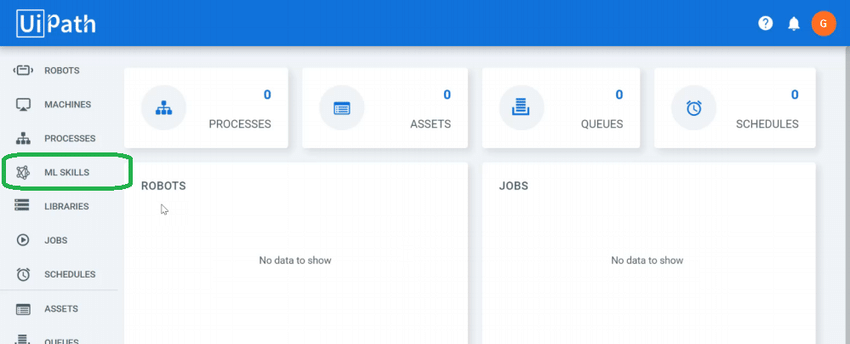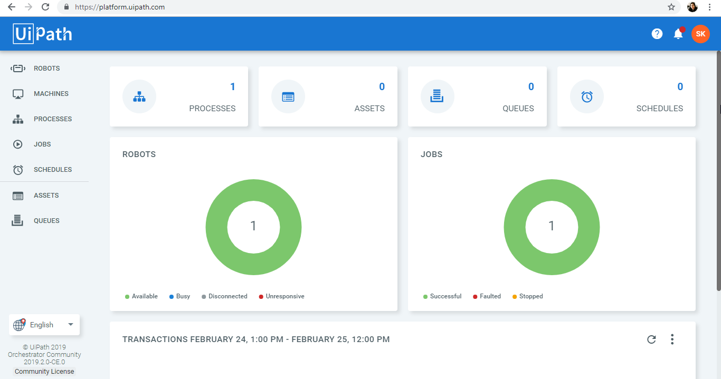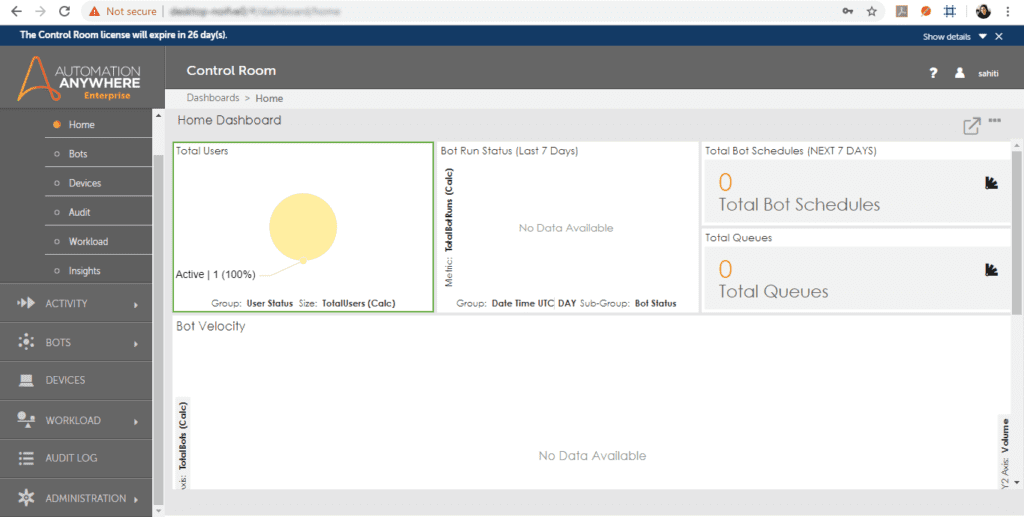Robotic process automation (RPA) is a technology that allows enterprises to automate some or all of their business processes. You can think of it as digital workers, which mimic manual tasks, so they are done with greater speed and efficiency.
RPA tools are used across all industries. In 2016, the global RPA spend was 300 million USD. That number is expected to reach 7.2 billion USD by the end of the year in 2022 and skyrocket to 10.4 billion USD by 2023.
The use of these tools has proved very useful in increasing productivity while reducing operational costs significantly. As RPA continues to infiltrate businesses across industries globally, there are two big players that companies typically turn to when trying to implement RPA solutions—UiPath and Automation Anywhere.
Both of these companies offer solutions for different industry verticals as well as specific functionalities. In order to choose between UiPath and Automation Anywhere, you need to know how both platforms compare against each other.
Table of Contents
Benefits of RPA Tools
Some benefits of RPA tools include:
- Increased productivity: Automation gives rise to increased productivity by doing tasks quicker than humans. The process gets sped up and takes less time than manually doing tasks would take.
- Customers get better services: Businesses with efficient automation processes help their customers get better service. They achieve higher degrees of accuracy and can perform faster without compromising accuracy or quality.
- Better employee efficiency: With effective use of RPA software, employees gain confidence as well as improve their overall efficiency while working on repetitive tasks.
- Improved operational agility: With technology like RPA becoming mainstream, businesses have a greater ability to respond rapidly to changes.
- Increased security levels: As there are no chances for human error since machines make fewer mistakes while performing tasks, there is also a minimal chance for confidential data leaks.
UiPath vs. Automation Anywhere
Here is how these solutions stack up against each other:
UiPath

UiPath is a cloud-based RPA platform that allows businesses to automate repetitive and non-differentiated tasks across their information technology (IT) environment. It automates business processes by recording and replicating user actions digitally through robotic software agents that mimic user behavior. The UiPath automation platform provides capabilities for scheduling, monitoring, debugging, versioning, and auditing.
Key Features of UiPath
- Drag-and-Drop Workflow Builder: Users can build an automation process in UiPath using a drag action to drop processes into the graphical user interface (GUI) of UiPath Studio and visually create them without writing code.
- Record and Playback: UiPath offers several types of recording options, including basic recording for automating single processes to develop each activity’s complete selector; desktop recording for multiple actions and application development; web recording, commonly used for viewing and recording web page activities; and Citrix recording, which is often used for recording pictures and virtualized environment automation.
- Process Deployment to Clients: UiPath can be delivered via an on-premises or cloud architecture, which makes it easier for business users to work with.
- Pre-Defined Activity Sets: UiPath users are able to automate a wide range of tasks, from simple workflows to more complex integration projects.
- Intelligent Scheduling of Process Automation: The scheduling module enables the orchestrator to run tasks based on priority. It prioritizes each task based on deadline, arranging work queues and assigning each task the appropriate priority.
UiPath Primary Components
The UiPath automation platform consists of three main components. They are:
- UiPath Studio: UiPath Studio is used for creating automation by writing code lines with visual drag-and-drop actions that don’t require the user to know how to code. All that is needed from users unfamiliar with coding is for them to drag operations onto different screens and link them together into procedures, or workflows.

- UiPath Robot: This component executes predefined workflows designed by UiPath Studio. With each execution, it can react differently based on received user inputs.
- UiPath Orchestrator: The Orchestrator works like a hub to orchestrate, execute, and monitor all robots’ activities, either triggered automatically by scheduled events or manually upon request. The Orchestrator is a web-based application centralized hub for managing and maintaining all software bots.

Pricing
UiPath provides a variety of price options to fit the needs of different types of customers. UiPath Unattended automation costs $1,380 per month, while a subscription to the automation team and an Automation Developer costs $1,930 and $420 per month, respectively.
UiPath also offers an enterprise-grade solution that can be tailored to your company’s needs. For more information about this plan, contact their sales team.
Also read: Blue Prism vs UiPath: RPA Tool Comparison
Automation Anywhere

Automation Anywhere is an RPA platform that helps businesses automate repetitive manual tasks without human intervention. Through a GUI, businesses can create and manage processes without writing code.
Key Features of Automation Anywhere
- Recorder: Users may use recorders to record, save, and run tests in automation anywhere. The platform offers three kinds of recorders. Smart Recorder records activity such as object cloning, Screen Recorder catches on-screen actions, and Web Recorder captures online data extraction.
- Screen Scraping: This functionality enables users to extract both structured (tables) and unstructured data spread across web pages.
- Predictive Operational Analytics: Automation Anywhere RPA analytics gives users insight into a bot’s efficiency and performance level.
- Workload Management: Workload Management supports the human prioritization of high-value tasks inside the automated queue management architecture.
- Task Editor: Users can create tasks by dragging and dropping components from the toolbox. The Task Editor allows the user to change, break down, and even enhance the recorded tasks.
Automation Anywhere Primary Components

- Bot Creator: It acts as a development environment. Developers use a drag-and-drop interface to design rule-based automation, which is then submitted to the Control Room and, if suitable, deployed.
- Control Room: This is basically the command and control center for all of your RPA robots. Robots may be launched, paused, terminated, or scheduled from the Control Room. Credentials and audit logs may be kept here as well.
- Bot Runner: This component operates robots on dedicated machines and has a similar appearance to the Bot Builder component, but its major function is to operate robots. The end-to-end status of the Bot Runner’s execution is transmitted back to the Control Room.
Pricing
The Automation Anywhere website does not provide pricing information. They do, however, offer a 30-day free trial and can provide detailed quotes tailored to your needs if you contact the sales team.
Features Comparison
| Product Features | UiPath | Automation Anywhere |
| Security | SOC 2 Type 2, ISO 9001, ISO/IEC 27001, and Veracode-Verified | SOC 1 Type 2, SOC 2 Type 1 and Type 2, ISO 27001, and FISMA Security Controls |
| Architecture | Web-Based Orchestrator Architecture | Client-Server Architecture |
| Deployment | Cloud and On-Premises | Cloud and On-Premises |
| Cognitive Features | AI-centered | IQ Bots |
| Attended Automation | Yes | Yes |
| Unattended Automation | Yes | Yes |
| Image Recognition | Yes | Yes |
| Reporting and Analytics | Yes | Yes |
| Process Builder | Yes | Yes |
Uipath vs. Automation Anywhere: Which Tool is Right for You?
When it comes to enterprise-level business automation software, UiPath and Automation Anywhere are two of the most widely used RPA platforms. Both tools have their advantages and are quite proficient in their capabilities. For this reason, it is necessary to evaluate the two platforms side-by-side in terms of functionality, cost, integrations with your enterprise’s existing systems, and other factors.
Reviewers considered UiPath to be easy to use, set up, and manage to help them better meet their business’s requirements.
Before selecting a tool, it is recommended that you request a demo from both providers before making a buying decision to evaluate which solution best fulfills your company use cases, gives the best return on investment, and provides the best value to your enterprise.
Read next: Top RPA Tools 2022: Robotic Process Automation Software


